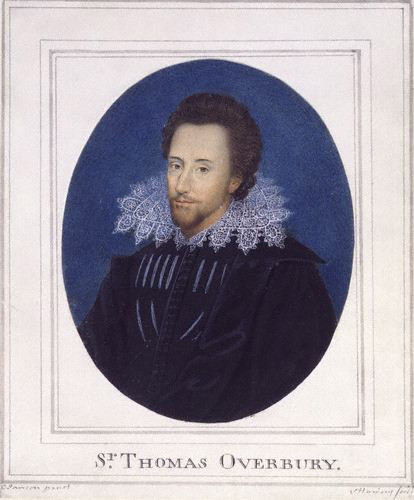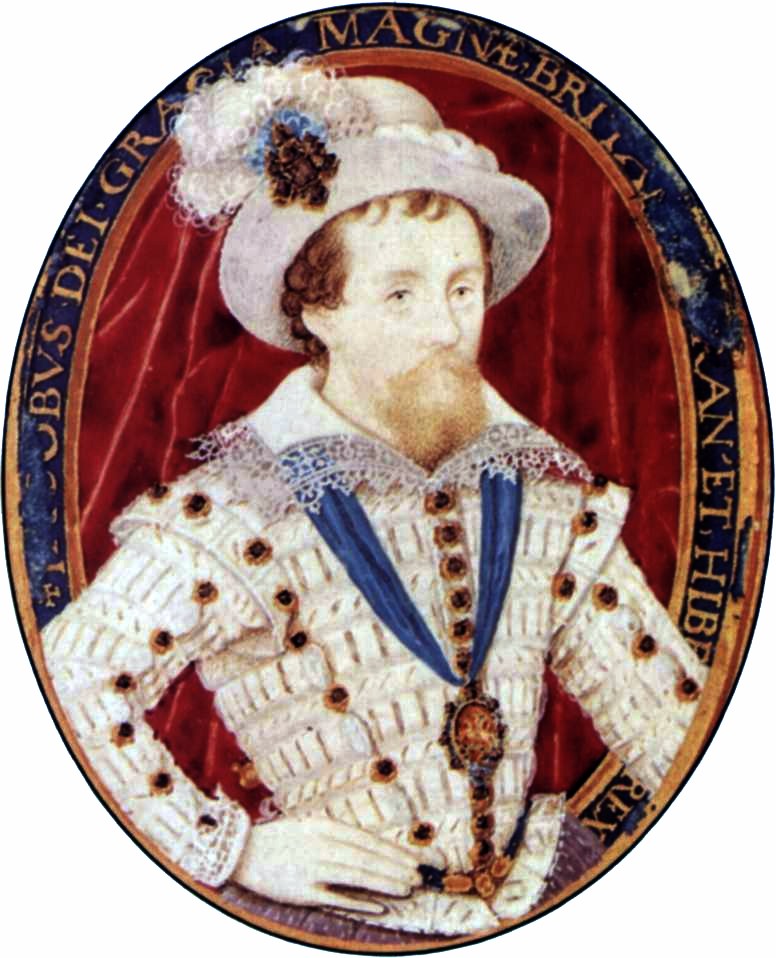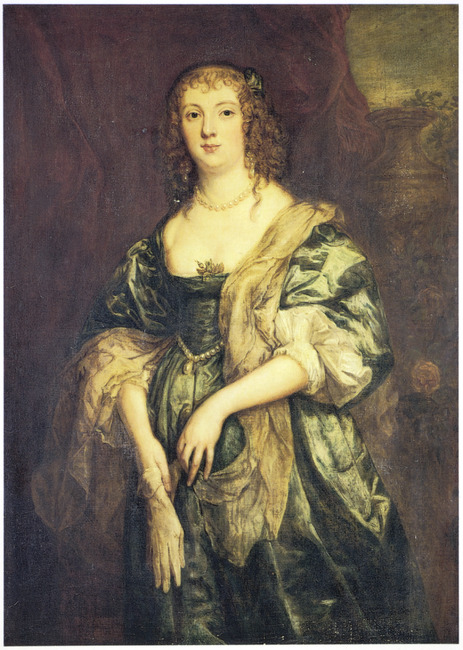by Susan Flantzer
© Unofficial Royalty 2021

Robert Carr, 1st Earl of Somerset; Credit – Wikipedia
Favorite: a person treated with special or undue favor by a king, queen, or another royal person
Born circa 1587, in Wrington, Somerset, England, Robert Carr, 1st Earl of Somerset was a favorite of King James I of England and held government positions until his supposed involvement in a murder led to his downfall. Robert was the youngest of the four children and the youngest of the three sons of Thomas Kerr of Ferniehirst, a Scottish landowner, a Roman Catholic and supporter of Mary, Queen of Scots, and his second wife Janet Scott of Buccleuch, daughter of Sir William Scott of Kirkurd, Younger of Buccleuch. Mary, Queen of Scots was a godparent to one of their sons.
Robert had three elder siblings:
- Sir James Kerr (died 1645), married Mary Rutherford, had one son
- Thomas Kerr (murdered 1601)
- Anne Kerr (died 1560), married John Elphinstone, 2nd Lord Balmerino, had one son
Robert had five half-siblings from his father’s first marriage to Janet Kirkcaldy:
- Andrew Kerr, 1st Lord Jedburgh (died 1633) married (1) Anna Stewart, had four children (2) Katherine McCulloch, no children
- William Kirkcaldy of Grange (died circa 1589), married Elizabeth Lyon, daughter of John Lyon, 8th Lord Glamis, had one son
- Mary Kerr, married James Douglas, son of William Douglas, 6th Earl of Morton
- Juliane Kerr (died 1 647), married (1) Patrick Hume of Polwarth, had four children (2) Thomas Hamilton, 1st Earl of Haddington, had one son
- Margaret Kerr (died 1594), married Robert Melville, 2nd Lord Melville of Monymaill, no children

Robert Carr’s friend Thomas Overbury; Credit – Wikipedia
Around 1601 while he was the page of a Scottish nobleman, George Home, 1st Earl of Dunbar, Robert met the poet and essayist Thomas Overbury, who was six years older, in Edinburgh. The two became friends and traveled to London together shortly after James VI, King of Scots succeeded to the English throne as James I, King of England upon the death of Elizabeth I, Queen of England in 1603. It appears that Thomas Overbury first obtained a position at court. In 1607, probably thanks to the influence of Thomas Overton, Robert participated in a tournament attended by King James I and attracted the king’s attention by breaking his leg.

King James I from the period 1603–1609; Credit – Wikipedia
King James I immediately took a liking to nineteen-year-old Robert, got him some medical treatment, and decided to improve his education. Robert did not have great intellectual gifts, however, he was good-looking, had a good temperament, and good character and this must have been enough for King James who knighted him and kept him under his wing.
Whether the personal relationship between King James I and his male favorites was a sexual one is still debated by historians. Some historians think that James I’s need for a close male favorite came from a lack of family while growing up in Scotland where he became King of Scots when he was one year old. James I did not know his parents Henry Stuart, Lord Darnley and Mary, Queen of Scots and he had no siblings. His maternal grandparents died before he was born. His paternal grandfather died while James was still a boy and his paternal grandmother lived in England.

The ruins of the old Sherbourne Castle, Robert Carr’s home; Credit – By Steinsky at the English language Wikipedia, CC BY-SA 3.0, https://commons.wikimedia.org/w/index.php?curid=4628974
In 1603, Sir Walter Raleigh, among others, was tried and imprisoned in the Tower of London for their part in the Main Plot, an alleged conspiracy by English courtiers to remove King James I from the English throne and to replace him with his cousin Lady Arbella Stuart. Through his attainder, Sir Walter Raleigh had forfeited his ownership in the manor of Sherborne in Dorset, England, now known as Sherborne Castle, and King James gave the manor to Robert. Robert’s influence over King James I had grown so much that in 1610, he was instrumental in persuading James I to dissolve Parliament, which had shown signs of attacking the king’s Scottish favorites. In 1611, Robert was created Viscount Rochester and named a Privy Councillor.
In 1612, when Robert Cecil, 1st Earl of Salisbury, Secretary of State died, King James I had the idea of governing by being his own Secretary of State and giving Robert many of the positions that had been Cecil’s. However, neither King James I nor Robert had the expertise or experience. Soon, the Howard faction, led by Henry Howard, 1st Earl of Northampton and Thomas Howard, 1st Earl of Suffolk, took control of much of the government. Robert struggled with the government positions assigned to him and had to ask his friend Thomas Overbury for assistance.

Frances Howard, Robert’s mistress and then his wife; Credit – Wikipedia
Before this time, Robert began an affair with Frances Howard, daughter of Thomas Howard, 1st Earl of Suffolk. Frances was married to Robert Devereux, 3rd Earl of Essex, the son and heir of Robert Devereux, 2nd Earl of Essex who was a favorite of Queen Elizabeth I and been executed for his part in an unsuccessful rebellion against Elizabeth. Robert Carr and Frances wanted to marry but Robert’s friend Thomas Overbury mistrusted the Howards and tried to prevent the marriage.
The Howard faction wanted to get rid of Thomas Overbury because of his influence, so they first manipulated Overbury into seeming to be disrespectful to Queen Anne, King James I’s wife. Next, the Howards persuaded King James I to offer Overbury the assignment as ambassador to Russia, aware that if Overbury refused, it would be insulting and nearly equivalent to treason. Overbury did decline the position and on April 22, 1613, Overbury was sent to the Tower of London, dying there five months later “of natural causes.”
On September 25, 1613, with the support of King James I, Frances’ marriage to Robert Devereux, 3rd Earl of Essex was annulled. Robert Carr was created Earl of Somerset on November 3, 1613, and then appointed Treasurer of Scotland on December 23, 1613. He had been named Secretary of State in 1612, and then Lord Chamberlain and Lord Privy Seal in 1614.

Robert and Frances’ only child, circa 1638; Credit – Wikipedia
Robert and Frances were married on December 26, 1613, and they had one daughter:
- Lady Anne Carr (1615 – 1684), married William Russell, 5th Earl of Bedford (later Duke of Bedford), had eleven children
Seemingly the plotting of the Howard faction worked as they had wanted until rumors of foul play in Thomas Overbury’s death began circulating. In September 1615, just as King James I was in the process of replacing Robert Carr with a new favorite George Villiers, later 1st Duke of Buckingham, the king received a letter from the Governor of the Tower of London. The letter stated that one of the warders had been bringing Thomas Overbury poisoned food and medicine. King James was not inclined to start an investigation however, when the rumor began hinting at the king’s possible involvement, he was forced to order an investigation. Edward Coke, considered the greatest jurist during the reigns of Elizabeth I and James I, and Sir Francis Bacon, Attorney General of England and Wales, were in charge of the investigation and then presided over the trial.
Six defendants – Robert Carr, his wife Frances, and Richard Weston, Anne Turner, Sir Gervaise Helwys, and Simon Franklin – were tried for the murder of Thomas Overbury in late 1615 and early 1616. It appeared very likely that Thomas Overbury was the victim of a plot contrived by Henry Howard, 1st Earl of Northampton and Thomas Howard, 1st Earl of Suffolk, with Robert Carr’s knowledge, to keep Overbury out of the way during the annulment of the marriage of Frances Howard and Robert Devereux, 3rd Earl of Essex.
It was not known at the time, and it is not certain even now, how much Robert participated in any crime or if he was ignorant of what was happening. However, Frances Howard was determined that Thomas Overbury “should return no more to this stage.” She arranged for Sir William Wade, Lord Lieutenant of the Tower to be replaced with a new Lieutenant of the Tower, Sir Gervaise Helwys. Richard Weston, a jailer who was “well acquainted with the power of drugs,” was to attend Overbury while imprisoned. Weston, aided by Anne Turner, the widow of a physician, and by an apothecary Simon Franklin, gave Thomas Overbury copper vitriol, today better-known as copper sulfate, an insecticide and fungicide.
Frances Howard admitted that she had a part in Overbury’s murder but Robert Carr maintained his innocence. Fearing what Robert might say about him in court, King James I repeatedly sent messages to the Tower of London pleading with him to admit his guilt in return for a pardon. In May 1616, Robert Carr and his wife Frances were found guilty and sentenced to death for their part in the conspiracy. However, they were not executed but remained prisoners in the Tower of London until they were pardoned and released, Frances in 1622 and Robert in 1624. The other four defendants – Richard Weston, Anne Turner, Sir Gervaise Helwys, and Simon Franklin – were found guilty in 1615 and, lacking powerful connections, were all hanged.
After their release, Robert and Frances lived in seclusion, apart from each other, and were not allowed to return to court. Frances lived the rest of her at the Howard family mansion Audley End House in Saffron Walden, Essex, England. She died at the age of 42, on August 27, 1632, and was buried in the Howard vault at Walden Abbey in Saffron Walden, Essex, England. Robert Carr resided in Dorset at Sherborne Castle and died there on July 17, 1645, at around the age of 58. He was buried at St. Paul’s Churchyard, Covent Garden, in London, England.
This article is the intellectual property of Unofficial Royalty and is NOT TO BE COPIED, EDITED, OR POSTED IN ANY FORM ON ANOTHER WEBSITE under any circumstances. It is permissible to use a link that directs to Unofficial Royalty.
Works Cited
- https://de.wikipedia.org/wiki/Robert_Carr,_1._Earl_of_Somerset
- En.wikipedia.org. 2020. Frances Carr, Countess Of Somerset. [online] Available at: <https://en.wikipedia.org/wiki/Frances_Carr,_Countess_of_Somerset> [Accessed 25 December 2020].
- En.wikipedia.org. 2020. Robert Carr, 1St Earl Of Somerset. [online] Available at: <https://en.wikipedia.org/wiki/Robert_Carr,_1st_Earl_of_Somerset> [Accessed 25 December 2020].
- En.wikipedia.org. 2020. Thomas Overbury. [online] Available at: <https://en.wikipedia.org/wiki/Thomas_Overbury> [Accessed 25 December 2020].
- Genealogics.org. 2020. Leo’s Genealogics. [online] Available at: <https://www.genealogics.org/> [Accessed 25 December 2020].
- It.wikipedia.org. 2020. Robert Carr, I Conte Di Somerset. [online] Available at: <https://it.wikipedia.org/wiki/Robert_Carr,_I_conte_di_Somerset> [Accessed 25 December 2020].
- Thepeerage.com. 2020. The Peerage. [online] Available at: <https://www.thepeerage.com/> [Accessed 25 December 2020].
